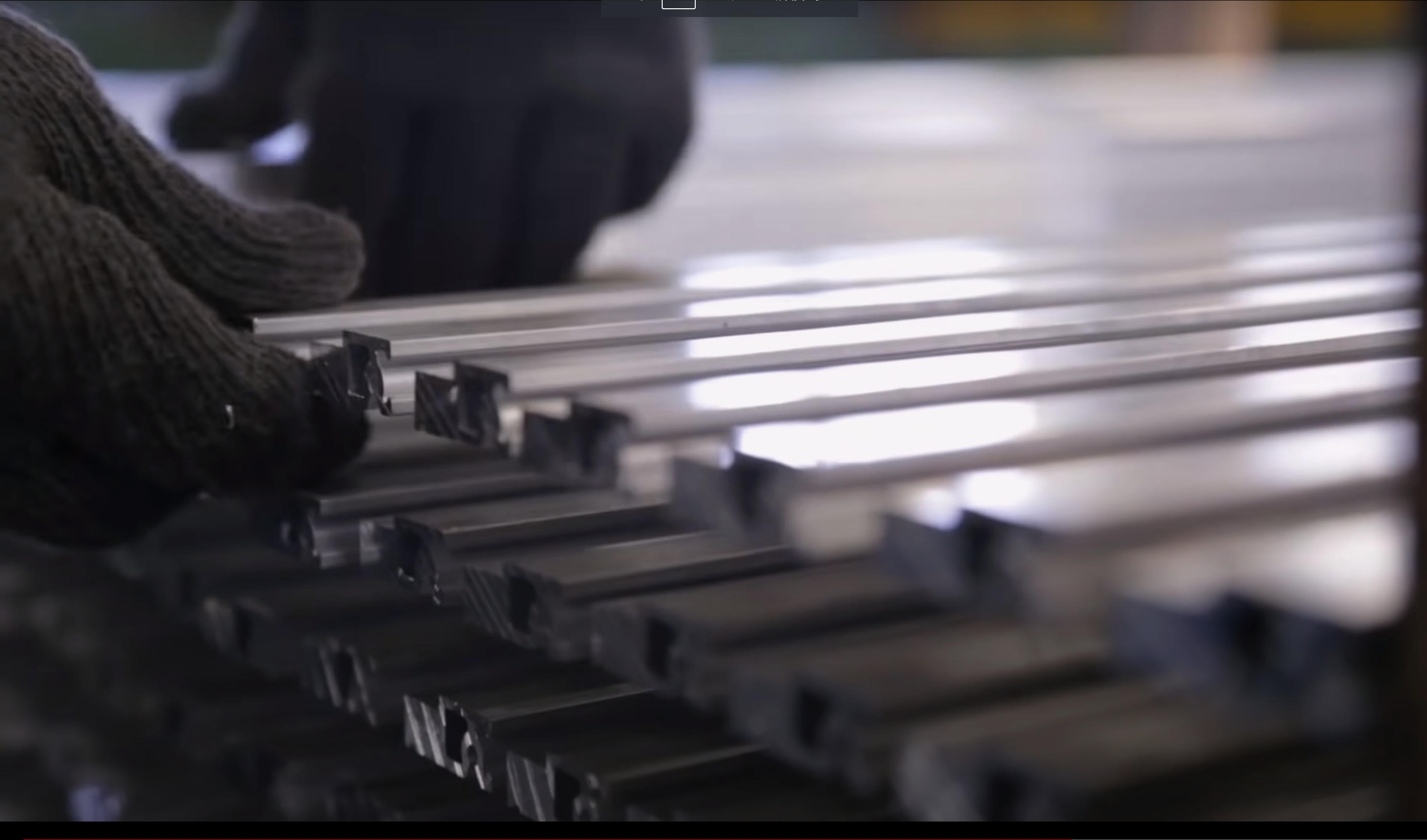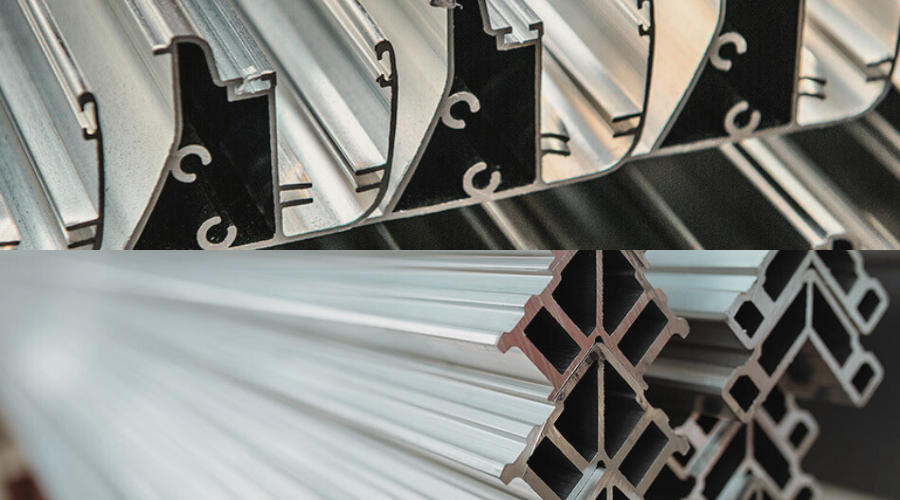
Introduction to custom aluminum extrusion
Aluminum extrusion is a manufacturing process that involves shaping aluminum into a specific cross-sectional shape using a die. The process starts with a cylindrical billet of aluminum that is heated to a temperature between 400°C and 500°C. The heated billet is then loaded into an extrusion press, which is squeezed through a specially designed die to create the desired shape. The die is typically made of steel and has a cavity that matches the shape of the profile to be extruded. The press applies force to the billet, pushing it through the die and creating a continuous length of aluminum with the desired cross-section. The extruded aluminum profiles can then be cut to the desired size, finished, and used for various applications, such as structural components, frames, heat sinks, and electrical enclosures.
Aluminum extrusion is a highly versatile manufacturing process that can produce complex shapes that are difficult to achieve with other methods. The process also allows for recycled aluminum, making it a sustainable manufacturing option.
The aluminum extrusion process
The aluminum extrusion process involves several steps.
Firstly, the aluminum billet is heated to make it malleable.
Secondly, the heated billet is placed in the extrusion press, and pressure is applied to force the billet through the die. The die is a custom-made tool that determines the final shape or profile of the extruded aluminum.
Thirdly, the extruded aluminum is cooled and cut to the required length.
Finally, the extruded aluminum is treated to improve its strength, durability, and appearance.
The benefits of aluminum extrusion
Aluminum extrusion offers numerous benefits for manufacturing capabilities. Here are some of the key benefits:
- Cost-effective: aluminum extrusion is a cost-effective manufacturing process because it requires fewer manufacturing steps than other metal forming processes. This makes it a more afforable option for manufacturers looking to create complex shapes and designs.
- Versatile:the versatility of aluminum extrusion is one of its greatest benefits. It can be used to create a wide range of shapes and sizes, from simple geometric shapes to more complex designs. This makes it ideal for a wide range of applications, from building and construction to automotive and aerospace.
- Lightweight:aluminum is a lightweight metal, which makes it an ideal material for use in industries where weight is a critical factor. Its low weight also makes it easier to handle during manufacturing and installation.
- High strength-to-weight ratio: despite its lightweight nature, aluminum is also incredibly strong. In fact, it has one of the highest strength-to-weight ratios of any metal, making it ideal for use in applications where strength is critical.
- Corrosion-resistant:aluminum is naturally resistant to corrosion, which makes it an ideal material for use in harsh environments. This makes it a popular choice for outdoor applications and in industries such as materials
Finishing options for aluminum extrusions
The surface finishing procedures applicable to aluminum extrusion include:
Basic mechanical finishing: Polishing, shot peening, and grinding can be performed to adjust the surface quality of aluminum profiles, sometimes preparing for other surface finishing.
Anodizing: Aluminum extruded parts can be anodized to give them a good appearance, with scratch resistance and antioxidant coating.
Painting: Regardless of whether the parts require matte, glossy, or textured finishes, painting is an effective method to change the color and surface appearance of aluminum extruded parts.
Powder coating: Powder coating is a suitable alternative to anodizing, with excellent chemical resistance and color consistency.
Screen printing: Screen printing is one of the simplest methods of adding text and logos to aluminum profiles, which is cheaper than machine based precision machining programs.
Laser engraving: Laser engraving can be used to add details, including text, to squeezing without erasing over time. Therefore, it is very useful for basic functions such as part serial numbers.

Applications of Aluminum Extrusion
Aluminum extrusions have a wide range of applications in various industries due to their unique properties such as high strength-to-weight ratio, corrosion resistance, and flexibility. Here are some common applications of aluminum extrusions:
Construction: Aluminum extrusions are commonly used in the construction industry for making doors, windows, curtain walls, and structural framing. They offer a lightweight and durable alternative to traditional building materials like wood and steel.
Automotive: Aluminum extrusions are used in the automotive industry for making parts such as heat exchangers, engine blocks, and body panels. They offer high strength and lightweight properties, which improve fuel efficiency and reduce emissions.
Aerospace: Aluminum extrusions are used in the aerospace industry for making parts such as wing structures, fuselage frames, and landing gear. They offer a high strength-to-weight ratio and excellent corrosion resistance, which is essential for aircraft parts.
Electrical: Aluminum extrusions are used in the electrical industry for making heat sinks, enclosures, and busbars. They offer excellent thermal conductivity and are lightweight, which makes them ideal for electronic applications.
Consumer products: Aluminum extrusions are used in the manufacture of consumer products such as furniture, lighting fixtures, and sporting goods. They offer an attractive finish and are easily customizable to fit specific design requirements.
Medical: Aluminum extrusions are used in the medical industry for making equipment such as wheelchair frames, hospital beds, and surgical instruments. They offer a lightweight and corrosion-resistant alternative to traditional materials like steel.
Overall, aluminum extrusions are a versatile and reliable material that can be used in a wide range of applications across various industries.
Conclusion
Finding the right manufacturer for your custom aluminum extrusion needs is crucial to the success of your manufacturing process. When choosing a manufacturer, it is essential to consider their experience, expertise, and reputation. Look for a manufacturer with a proven track record of producing high-quality extruded aluminum products. It is also important to choose a manufacturer with the latest technology and equipment to ensure the best possible results.
HordRT is a trusted name in this industry. It offers reliable aluminum extrusion services that help achieve consistent results. If you have any new projects, please do not hesitate to contact us.
-q4gvl4k29y4hq8j9rjpapvj0ft06fje63olt7p210i.png)


